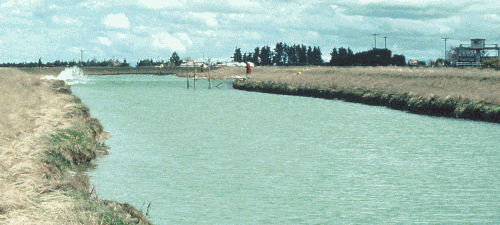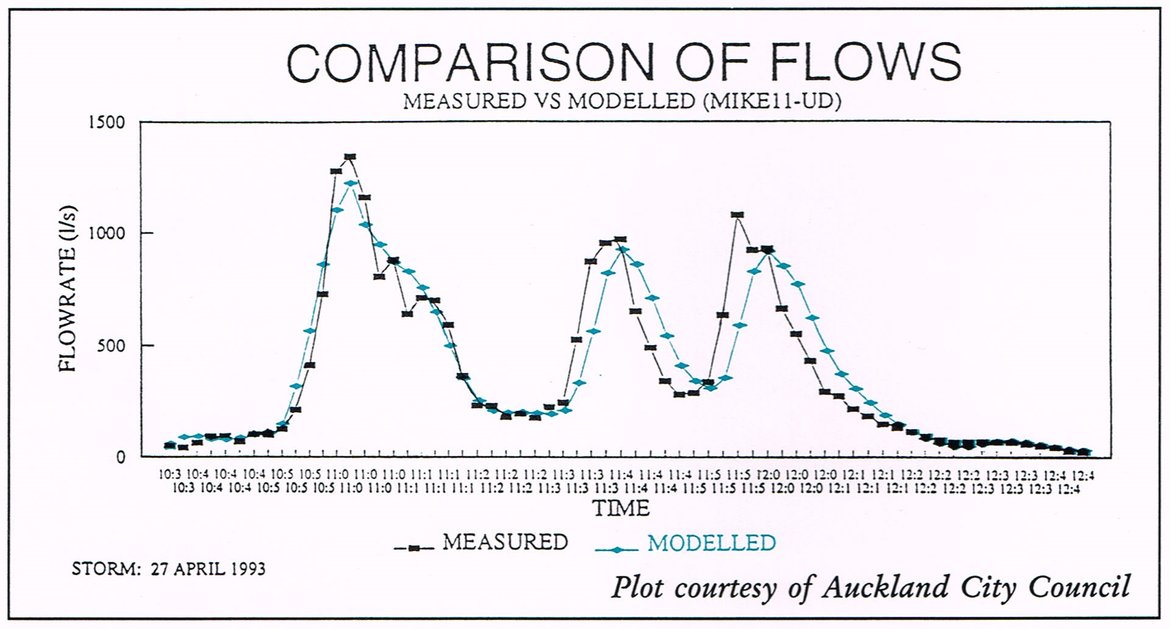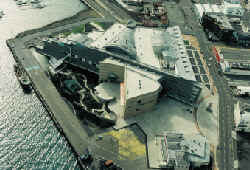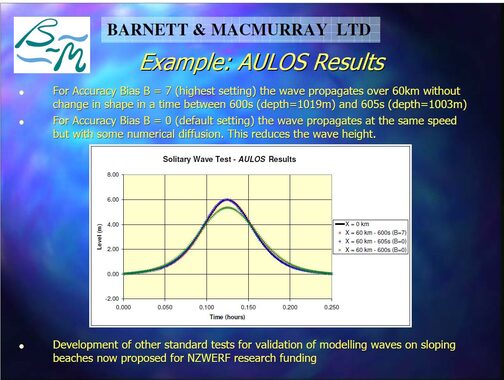Software Accuracy Benchmark established by IAHR, met by AULOS
The Flood Risk Management Committee of the IAHR has published an accuracy benchmark, as described in the document at this link. (The document is only available to members of the IAHR)
To date, AULOS is the only package for which validation has been announced to fully meet the urban stream benchmark, and you can download this validation document here.
You can download the benchmark test data from a link that is given in the validation document, but access is restricted to IAHR members or those with colleagues who are IAHR members.
Examples
Over the last 30 years AULOS has been extensively used in New Zealand and around the World on major hydraulic modelling projects, some of which are described on the linked pages below.
Rangitata canal model tests
The picture shows a wave progressing along a canal in the late 1970’s, Measurements were made and compared with the calculations of early versions of AULOS, and showed that the model precisely forecast the wave motion. Although this wave was in a canal, this gives a replication of wave height, speed and water depth at full scale for a small tsunami approaching a coastline. AULOS is based on over 30 years of continuous development, including these models developed to ensure that water flows through the huge canal network of the Upper Waitaki were controllable.
More recently, AULOS has been used to verify real time control improvements in this system.
Linked Hydro Dam Facility
A cascade of eight dams generates hydroelectric power from the Waikato River, the largest in the North Island, New Zealand. During major floods, flow changes at any dam affect the operating conditions for all the others. This means that the operation of any control gate must be linked to the operation of all control gates. Generalised from principles developed for the Waikato problem, the AULOS Waikato Cascade Analysis facility now provides a logical structure through which operational flood management strategies can be developed and tested for any cascade of dams.
Auckland CBD drainage study 
The central downtown region of Auckland City has primary piped networks and secondary flow paths through street junctions, interlinked by stormwater catchpits. Although other software could be used for steeper catchments feeding the central region, and for the sanitary sewage system, the Council established that the sophisticated major/minor flow model required for the central city needed key features of Mike 11 UD, an extension to Mike 11 based on an early version of AULOS. These features have been extended further in recent version of AULOS . The diagram shows the match between measured and modelled flow.
Tsunami investigation for National Museum, Wellington, NZ
The Museum of New Zealand (Te Papa) is a landmark building containing national treasures, and constructed on the edge of Wellington Harbour in a region classified as a tsunami hazard area. Before construction of the museum, Dr Barnett used the modelling techniques incorporated in AULOS to show that tsunami could inundate the proposed site, leading to substantial changes to the site and the location of exhibits on the first floor and higher in the building.
A paper based on this project is described in the Proceedings 1998 IPENZ Conference, Auckland, Volume 3, pp. 113-118. This paper received two major awards:
- Winner, Fulton Downer Gold Medal, best technical paper, 1998 IPENZ Conference
- Winner, Brian Brown Award, best water-related paper, 1998 IPENZ Conference
Click here to download the 1998 IPENZ Conference Paper
AULOS was used to model the effects of tsunamis on the Te Papa Museum. Click here to see a television broadcast on 15 February 1998 at the time of the Te Papa opening. (Interview Copyright TVNZ.)
Validation of Tsunami and Dambreak Hazard Models
A presentation on this subject was made to the modelling workshop of the New Zealand Water and Wastes Association in Auckland in September 2005. It proposes a simple standard quality assurance test for comparison of Dambreak solutions, using selected results from an extensive set of laboratory dambreak experiments conducted by the US Army Engineer Waterways Experimental Station in Vicksburg, Mississippi in 1959-60.
It should take under an hour to set up a model of the experimental layout fully described in the notes, and to compare the results with the provided experimental data.
Click here to download a pdf copy (1350kb) of the presentation.
Click here to download an excel file of the test data (42kb)
Why AULOS gives you more accuracy, faster
Many modelling tools are available, but most of them oversimplify the task to make it easy for simple computation methods to be used. To model the behaviour of the water you use some basic principles of physics – conservation of mass, conservation of energy, and conservation of momentum. The commonly used ones use the conservation of momentum, and work well in simple situations, but for a full and accurate model you must model the conservation of energy as well. AULOS is unique in the way that it does this, offering unsteady energy analysis that extends your solutions well beyond those given by momentum analysis.
Although some deeply abstract physics has gone into developing AULOS, it is intended as a tool for design engineers working in both small scale and large scale real-world situations. For example, when you use AULOS to do unsteady energy analysis in a practical stormwater design situation, you may find that the peak upstream level is half a metre higher than that predicted by full dynamic momentum analysis. While this might not overtop freeboard allowances, it does affect the true value of the return period for overflow. A design done in this situation using the momentum (St Venant) equations could have a flood protection return period of perhaps only 10 years when the design code required 100 year protection.
In more complex situations you will find that you cannot model the system at all, or in a sensible time frame, without AULOS . An example of this is the modelling of systems that combine overland flow and piped or channelled flow. This is important in modelling designs that rely on overflows in extreme events, such as the Auckland City example described elsewhere on this site. These designs use distributed surface ponding areas to reduce construction costs and to improve stormwater quality. By using AULOS, you can design realistically, by allowing for controlled inundation up to permitted limits. This can typically save 10% or more of the capital cost compared with conventional design of drainage projects, with the added assurance of closer conformance to design code specifications.
The physics and mathematics of the key algorithm
An analysis of the problems with unsteady flow models has been based on the Full Hydraulic Equations, a complete set of unsteady energy, momentum and mass equations. “Cell integral analysis” is our name for a novel method of linking the physical continuous system to a finite grid. This analysis determines the reasons for solution instability, and shows it is linked to limited areas of physical instability. Software can therefore be written using this new analysis to provide maximum accuracy with the computing resources available.
Cell integral analysis uses piecewise analytical integration instead of finite difference techniques to get a great increase in computation speed - up to 100 times faster! Briefly, this arises from the use of functions other than polynomials to extrapolate from a particular point of the solution. The better the function represents the physical system, the larger the steps which can be used to reliably extend the solution.
The technique uses four dimensional finite volume cells to develop the complete mass, momentum and energy equation set, instead of the standard St Venant equations. This resolves dangerous conflicts between energy and momentum solutions when abrupt changes in cross section occur, especially at changes from open channels to pipes in artificial channels.
Designer’s credentials
Dr Alastair Barnett has in-depth knowledge of modelling, and is the main designer and programmer of AULOS
His career is as follows:
- Ph.D., (Civil Engineering)
- Registered civil engineer
- 50+ years of experience in computational studies of water flow in engineering studies in 20 countries
- Studies on harbours, hydro power channels, and drainage networks, including field monitoring programs for model calibration and verification.
- Development of several original software packages for hydraulic analysis.
- Elected to IAHR Flood Risk Management Committee in 2016
- Winner of several awards for outstanding papers on hydraulic modelling studies.
- Principal of Barnett Consultants (now Barnett & MacMurray Ltd) since 1987.
- Scientist, Ministry of Works and Development, 1978-1986
- Senior Engineer, Ministry of Works and Development, 1965-1977.
- More than 60 papers, published in North America, Europe, Asia, Australia and New Zealand.
